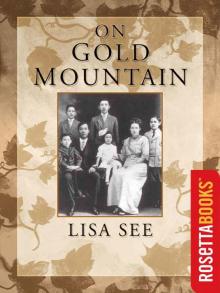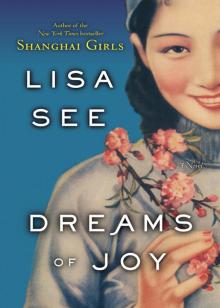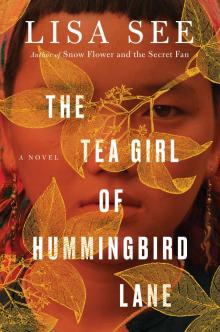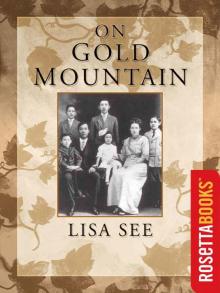On Gold Mountain Read online
Page 5
Of all the “lies” that Fong See told, perhaps none is more slippery and elusive than those regarding his age. One family story is that he was two weeks short of his hundredth birthday when he died. Aunt Sissee used to say that when her father got to a certain age he liked to tack an extra year onto his actual birthday—on Chinese New Year’s or at the birth of a new child—so that by the time he died, he was telling customers that he was 120 years old. As for “hard” fact, in his immigration files Fong See states on several occasions that he was born in 1866 (not 1857) and landed in the United States in 1881, when he was fifteen. Then, beginning in 1917, he changed his story, telling immigration officials that he couldn’t remember when he was born or when he came. But the immigration files are often unreliable, riddled as they are with tricky questions and equally tricky answers.
In his day-to-day life, Fong See told newspaper reporters and customers that he arrived in the United States in 1871 and moved to Los Angeles in 1874. This was partly true. Fong See incorporated his store in Sacramento in 1874, but didn’t settle in Los Angeles until 1897.
It might be well to consider what one of his grandchildren has said: “If you tell a lie, then you must have a motive for telling that lie.” So perhaps in this wonder time we can give Fong See his invented history with all its exaggerated truths and concrete fantasy. Since Fong See saw himself—publicly advertised himself—as a man who had his feet on Gold Mountain soil in 1871, then perhaps that is when he arrived: after crossing the ocean not on a Pacific Mail steamship (the preferred method of travel) but on a clipper ship, “carried over by the wind,” as his fellow countrymen called it—at the age of fourteen, already a married man.
CHAPTER 2
EXCLUSION
1872–93
NOT long after Fong See caught the riverboat to take him up the American River to Sacramento, John Milton Pruett and his family were packing their belongings into the prairie schooner that they’d bought to transport themselves and all their possessions from Pennsylvania to Independence, Missouri. From there they planned to join a wagon train and continue west along the Oregon Trail to what they hoped would be a better life.
Back in 1803, the Louisiana Purchase had legally extended the boundary of the United States’ territories to the Rockies in the Northwest. But, boundary or no, trappers and hunters were already penetrating into the area beyond, while along the Pacific Coast, ships actively explored rivers and harbors, seeking places to pick up sea otter pelts to trade with China. The United States wasn’t the only country interested in this land so rich in natural resources. The British also wanted a share, as did the French, Russians, and Spanish. The idea of physical occupation had long been the basis for claims of sovereignty, and here that principle was at work again. Even as Britain’s Hudson’s Bay Company became increasingly entrenched, American settlers in the Willamette Valley in northwest Oregon argued for recognition by the United States government.
In 1845, President Polk notified the British Foreign Office that the United States planned on assuming complete sovereignty over the Oregon country. The following year, Great Britain agreed on condition that the forty-ninth parallel become the boundary. Even so, the U.S. government needed homesteaders in the territory to continue to establish sovereignty. Lured by a vision of almost unlimited agricultural opportunities and the promise of up to 160 acres of free land if single and 320 acres if married, provided that they built a house on that property within twelve months, settlers began their trek west.
The first pioneers along the Oregon Trail had the luxury of open land with plenty of grass and good water for the horses, oxen, and other livestock that accompanied families on their journey to their new homes. Still, there were hardships aplenty. Children too young to walk sometimes fell off their family wagons to be crushed by the wheels. Most died instantly; others lingered, dying awful deaths as their lives literally jostled out of them as their parents continued their arduous westward march. There was no time to stop, no time to linger, no time to mourn. They had to cross the mountains before winter set in.
By May 1872, when John Pruett, his wife, and four sons left Pennsylvania for new opportunities, the Oregon Trail had been much traveled. In some places the relentless passing of wagon wheels had ground ruts deep into solid rock. The four-hundred-mile stretch from the Platte River in Nebraska to Fort Laramie in Wyoming averaged twelve graves to the mile. Indians, who had been relatively solicitous in the early days, now saw clearly what lay ahead. Although many of the Indian nations signed treaties, others resisted forcibly. Along the trail, the Pruetts passed through Pawnee, Cheyenne, Sioux, and Shoshone territories. In Oregon the native population had been pacified to a great extent, but during the last twenty years there had been several uprisings where settlers saw their homes burned, and lives on both sides were lost.
Perhaps even worse, the land along the trail had been totally stripped of vegetation. Whatever livestock this last wave of pioneers brought with them, they would have to pack along feed for it. Fortunately, the Pruetts were Pennsylvania Dutch and not given to concerns over worldly possessions. With no tears, Luscinda Pruett gave away her embroidered tablecloths, all her china but the most durable, and whatever else the family thought they could live without, to make more room in the wagon for grain and water. Thus prepared, the Pruetts began the dusty two-thousand-mile trek—from Independence to Fort Kearney, from which point they followed the Platte River to Fort Laramie, past Independence Rock, and across Sublette’s Cutoff to Soda Springs. From there they went south along the California Trail, then north again along the Applegate Trail, past Klamath Lake to the Rogue River Valley. After five months the Pruetts arrived in Oregon.
Since the best land in the Willamette Valley had already been homesteaded, the Rogue River Valley was the final destination for the Pruetts and other pioneers throughout this decade. Even along the Rogue, the only plots left were in the Big Sticky, a name coined by the Indians for the soil that clung in gluey clumps to wagon wheels, moccasins, and horses’ hooves. The Pruetts searched until they found the abandoned homestead of Samuel M. Hall, equidistant between Central Point and an area that would one day become Medford.
On October 12, 1872, John Milton Pruett went to the office of land patents and registered for the property. He now had his farm as well as four strong sons, another son on the way, and a wife who, in fourteen years of marriage, had proved herself a hard worker, faithful, and trusting in the Lord. Together they began the backbreaking work of clearing the manzanita, chaparral, and grass that grew on the valley floor as high as a horse’s shoulder. God willing, they would make a good life for themselves.
Until his Number Four son appeared on the doorstep of the Kwong Tsui Chang Company after searching the few herbal emporiums in Sacramento, Fong Dun Shung had thought he would never see his home village again. But with his son’s arrival and after hearing about Shueying’s hard life, he decided to go home. Within months of his reunion with Fong See, Fong Dun Shung left his three sons in California to take care of the shop, and returned to Dimtao a rich man with plenty of gold pieces to show for his years away. How the peasants stared at him! How rich he looked in his western clothes! How prosperous he appeared when his bearers set down not only his original Gold Mountain basket, but other baskets as well, filled with strange items from the foreign land. And how cowed his Number One wife was when she saw her husband’s Number Two wife step down from her sedan chair swathed in embroidered pale blue silk.
During his first days home, Fong Dun Shung hosted a banquet to show off his new wife, his wealth, his booty to all the neighbors who had thought him dead or lost forever among the white demons. He paid his respects to the ancestral graves—pulling weeds, laying out offerings, lighting incense, performing every prescribed custom to atone for his long absence. Only Fong Dun Shung, who had been to the Gold Mountain and had seen real riches, knew that he was not the big man the villagers thought he was. Keeping that knowledge to himself, he built a two-room brick house
with an attached kitchen shed and settled back for what he thought would be his indolent years—a little gambling, sex with his wives, the birth of grandsons and sons.
It was not to be. Every day for a year or so he listened to his wives argue, but he found he was not strong enough to scold them into silence. What could he say to them? He had deserted his first wife; after what seemed a lifetime in the civilization of Sacramento, he had brought his second to what he now recognized as a backward village. During those nights he spent at her side, she whimpered and cried to go back to the Gold Mountain.
“This is your home now,” he whispered in her ear. “You are a China girl. You belong here with me, your husband.” But he knew it had been a mistake to bring her back to Dimtao. His Number Two wife had been born in China, but had been sold and shipped to the Gold Mountain as a child. She had grown used to the ways of the white ghosts—their sounds, their bodies, their dress, their food. She could not remember the ways of village life—the poverty, the crudeness, the gossiping.
From the cock’s first crowing until the stars rose in the heavens, he listened to the arguing of the two women.
“Scum of a snail,” Shueying might hiss, as she heated the wok for the evening meal.
“Red-faced peasant,” his Number Two wife might retort.
“Barren wife of one thousand men,” Shueying would shout, then comfort her infant son, Fong Yun, with gentle caresses and cooing words.
“Turtle’s-egg abortion,” the California wife might snort back as her chopsticks clicked rudely on the side of her rice bowl.
“Concubine who is as diseased as the leper who begs on the streetcorner.”
In this battle of wives, which was as old as China itself, he knew that his second wife would lose. Although she had proved to be barren—and none of his herbs or potions had helped her—she had kept him content for many years. But she was certainly no match for a wife whose name meant “heroine of the snow.”
One day during Fong Dun Shung’s second spring home, he ate his jook—rice gruel—belched to show his satisfaction, perfunctorily scolded his Number One wife for her laziness, then walked out to see if there was a man in the village willing to leave his fields to indulge in a gamble. At noon he returned for lunch. He slurped his noodles and lay down on his pallet to sleep through the enervating heat of the afternoon. Later, Shueying awakened him, shaking his shoulder and whispering, “Come quick, husband. The sow who calls herself your wife will not move.”
When he reached his Number Two wife’s bedside, he found her staring unseeing at the ceiling. The lines of worry and sadness that had clouded her face in this last year had smoothed again into the porcelain planes that he remembered from their years together in California. Only her open mouth, with its piece of gold on her tongue, showed the cause of death. Like the leader of the T’ai P’ing Rebellion, whose own dreams had been dashed, Number Two wife had committed suicide by swallowing gold.
How long had this wife suffered? Number Two wife could have called out, could have changed her mind, but for the only time in her life she had chosen her fate. Her determination was so great that they found her lying peacefully in death with her hands held rigidly at her sides, her clothes unwrinkled.
So it was that Fong Dun Shung’s Number Two wife passed from birth to death with no one to remember or record her name. She was a disgrace, a secret. To forget her name might mean that she had never existed. Over months and years, people would begin to forget, only to be reminded by a village gossip, an unhappy wife, or an unfortunate nephew whose life in the Gold Mountain had been shrouded in poverty and unhappiness. In later generations there would still be one or two who would remember, sneer, and lewdly whisper, “You know, she was a prostitute.”
Perhaps in despair, perhaps dulled by boredom, Fong Dun Shung went back to his old ways and gambled away the rest of his Gold Mountain gold.
Between 1871 and 1874, Fong See witnessed incredible changes in the land and in the quality of life of Sacramento’s citizens. Many of the “civilizing” changes were the direct result of the efforts of his countrymen. He watched as the tule marshes, peat bogs and silty waterways that made up the Sacramento delta had been reclaimed by the Chinese. Draft animals couldn’t do the work, since their hooves sank in the mud; whites wouldn’t do the work because it was too hard and unhealthy. Toiling in water up to their waists, Chinese laborers built miles of levees, ditches, dikes, canals, and irrigation channels to drain the swampy land. By the time they were done, 500 million acres in the Sacramento area were reclaimed and land values rose from one dollar to one hundred dollars an acre. But the Chinese owned none of it, since the Alien Land Act of 1870 forbade the ownership of American land by Chinese.
As the land was reclaimed, Chinese laborers plowed and planted. They spent their waking hours packing peaches, apples, and pears, harvesting hay, digging asparagus, and picking beans, strawberries, and cherries. Every day they looked forward to the same stooped labor, except for rainy days, when the landowners required them to make bushel baskets. As on the railroad, a dollar a day seemed adequate wages for either reclamation or farm work—ten to twenty dollars a month less than the going rate for white workers in California, but more than for workers of any color in other states.
Other Chinese laborers worked in woolen factories or in paper and knitting mills. They built highways and railroad lines to crisscross the state. They cut wood and cleared land. Some worked in borax beds or salt works. In the hops fields, they gathered, cured, and sacked the crop, which then went to breweries where other Chinese saw to fermentation and bottling. They helped raise and slaughter pigs and poultry. They rolled cigars and cigarettes. They manufactured slippers, pantaloons, vests, skirts, drawers, overalls, and shoes. A few went south to Monterey, where they fished, not just for the usual fare eaten by Caucasians, but also for abalone and shrimp. Since most Americans found these odd ocean tidbits not only unpalatable but also conclusive evidence that the Chinese were subhuman and had the tastes of animals, the shellfish were salted and shipped back to China. Along the way a sub-industry was invented: abalone shells could be polished and used in all manner of decorative arts.
From San Francisco, some Chinese went to sea as coal heavers, deckhands, cabin servants, and sailors. Others tried making harnesses or bricks. Still others became coachmen or house servants. A few started their own businesses, opening small laundries, keeping a few whores in cribs, or running little chop suey joints, grocery stores, or butcher shops—all catering to the same clientele—the people of Fong See’s home country.
His countrymen were popular among landowners and factory owners. The Chinese, it was said, were always at their work stations on time. They didn’t lag or loiter; they didn’t gossip like American factory girls. But, to the public at large, these jobs were invisible. No man ever considered who rolled his cigar, cut the wood for his fireplace, or made his underwear. So the importance of the Chinese in supporting the whites’ rising standard of living went largely unappreciated. Still, a few believed that any sudden expulsion of the Chinese would throw the entire state into confusion.
Fong See had done many of these jobs himself. He constantly tried to improve himself—with work first, then with language, dress, and attitude. When he first arrived, he worked in the potato fields, earning a dollar a day, where he pulled weeds, hoed, then later dug up the tubers. He had never done farm work before, not even in his home village, and it seemed interminable and hot. He decided that he was more suited for indoor work and did whatever jobs he could find for a boy still in his teens. For a short time he worked as a helper in a laundry. Sweeping floors and washing dishes in a restaurant, he learned how to cook, which prepared him for a job as a cook in a brewery and later at a ranch.
In time he found that the best job was to walk from door to door, selling merchandise. He sold hats, brushes, curtain rods—whatever he thought someone might buy. The white women who answered the door were mostly kind and gracious. Emboldened, he engaged them i
n conversation beyond his sales pitch. Amazingly, they listened and responded. His English improved and his opportunities expanded. He was only seventeen years old, but he already knew that to get ahead in this country he would have to be his own boss.
On June 24, 1874, Fong See walked into the office of Sacramento’s city clerk. Although the people with whom he had worked during these past few years had always told him to beware of the white ghosts, Fong See was not afraid. He stepped up to the high counter and carefully said the words, “I want to sign paper to make business.” After just three years in the Gold Mountain, Fong See’s English was still rudi mentary; the man behind the counter could easily have made fun of him, mocking his hesitant English in the quacking tones of the vaudeville Chinaman: “I wantee signee paper makee work-work.” But the clerk had not seen many Chinese pass through this office, and chose to be helpful. He opened the registry of partnerships and wrote in what little information he could ascertain—a name, a date. The columns listing the type of business and the names of the business partners were left blank.
In celebration of his official papers, Fong See walked to the Conrad Young Photography Studio on J Street. The photographer positioned him and ordered him, “Don’t move. Don’t move,” then disappeared behind his black fabric-draped box. Fong See looked directly into the camera lens. At seventeen years, his skin was smooth and hairless. His mouth was full, his nose flat and wide. His face was fuller than it would be in later years, when its angularity and high planes would seem to drop decades from his years. As usual, his bowler hat was tipped back on his head, his queue rolled up and tucked inside it.

 On Gold Mountain: The One-Hundred-Year Odyssey of My Chinese-American Family
On Gold Mountain: The One-Hundred-Year Odyssey of My Chinese-American Family Snow Flower and the Secret Fan
Snow Flower and the Secret Fan Peony in Love
Peony in Love Flower Net
Flower Net Dragon Bones
Dragon Bones Shanghai Girls
Shanghai Girls Dreams of Joy
Dreams of Joy The Island of Sea Women
The Island of Sea Women The Tea Girl of Hummingbird Lane
The Tea Girl of Hummingbird Lane China Dolls
China Dolls The Interior
The Interior On Gold Mountain
On Gold Mountain